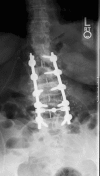Degenerative scoliosis: a review
- PMID: 23024623
- PMCID: PMC3192887
- DOI: 10.1007/s11420-011-9204-5
Degenerative scoliosis: a review
Abstract
Degenerative lumbar scoliosis is a coronal deviation of the spine that is prevalent in the elderly population. Although the etiology is unclear, it is associated with progressive and asymmetric degeneration of the disc, facet joints, and other structural spinal elements typically leading to neural element compression. Clinical presentation varies and is frequently associated with axial back pain and neurogenic claudication. Indications for treatment include pain, neurogenic symptoms, and progressive cosmetic deformity. Non-operative treatment includes physical conditioning and exercise, pharmacological agents for pain control, and use of orthotics and invasive modalities like epidural and facet injections. Operative treatment should be contemplated after multi-factorial and multidisciplinary evaluation of the risks and the benefits. Options include decompression, instrumented stabilization with posterior or anterior fusion, correction of deformity, or a combination of these that are tailored to each patient. Incidence of perioperative complications is substantial and must be considered when deciding appropriate operative treatment. The primary goal of surgical treatment is to provide pain relief and to improve the quality of life with minimum risk of complications.
Keywords: adult deformity; adult scoliosis; degenerative scoliosis; secondary scoliosis; spinal stenosis.
Figures
References
LinkOut - more resources
Full Text Sources
Medical




